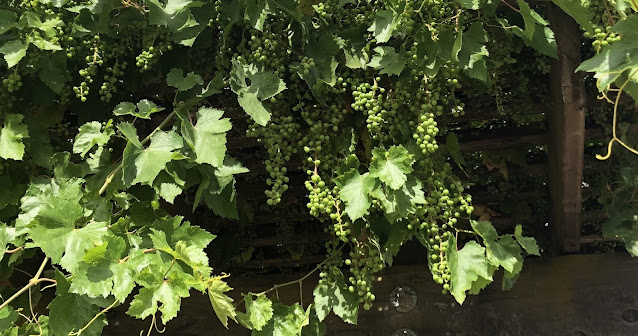
Clouds to provide some relief from triple-digit heat

|
|
Growing grapes? Thin them now for bigger, better clusters later. (Photo:
Kathy Morrison)
|
Clouds are coming to our rescue – and maybe a little rain, too!
After two days of excessive heat, some possible showers and the cloud cover that comes with them are expected to cool Sacramento down several degrees.
According to the National Weather Service, Sacramento has a 30% chance of rain Sunday morning, followed by breezy conditions through Monday. Instead of triple-digit afternoons, our highs will hover in the mid 80s.
Once the breeze dies down, the temperatures will begin to climb again, peaking just below 100 on Wednesday. Then, another dip back into the 80s is expected by next weekend, says the weather service.
In case you’re wondering, the hottest June day in Sacramento history: 115 degrees. So, a mix of 80s and 90s isn’t so bad.
Expect more odd behavior from plants during these yo-yo temperatures. The important thing is to keep soil from drying out completely; mulch works wonders for retaining moisture and keeping roots comfortable. To avoid evaporation, water early in the morning.
Watch out for heat stress – both for you and your pets and plants. When temperatures climb, retreat inside.
* Let the grass grow longer. Set the mower blades high to reduce stress on your lawn during summer heat. To cut down on evaporation, water your lawn deeply during the wee hours of the morning, between 2 and 8 a.m.
* Tie up vines and stake tall plants such as gladiolus and lilies. That gives their heavy flowers some support.
* Dig and divide crowded bulbs after the tops have died down.
* Feed summer flowers with a slow-release fertilizer. Remember to water first.
* Avoid pot “hot feet.” Place a 1-inch-thick board under container plants sitting on pavement. This little cushion helps insulate them from radiated heat.
* Thin grapes on the vine for bigger, better clusters later this summer.
* Cut back fruit-bearing canes on berries.
*Warm weather brings rapid growth in the vegetable garden, with tomatoes and squash enjoying the heat. Deep-water, then feed with a balanced fertilizer. Bone meal can spur the bloom cycle and help set fruit.
* Generally, tomatoes need deep watering two to three times a week, but don’t let them dry out completely. That can encourage blossom-end rot
* Feed camellias, azaleas and other acid-loving plants. Mulch to conserve moisture and reduce heat stress.
* Plant basil to go with your tomatoes. There’s still time to plant radishes, sunflowers, melons, pumpkins and squash from seed.
* Transplant summer annuals such as petunias, marigolds and zinnias.
* Transplant perennial flowers including astilbe, columbine, coneflowers, coreopsis, dahlias, rudbeckia, salvia and verbena.
Comments
0 comments have been posted.Sacramento Digs Gardening to your inbox.
Sites We Like
Garden Checklist for week of July 21
Your garden needs you!
* Keep your vegetable garden watered, mulched and weeded. Water before 8 a.m. to reduce the chance of fungal infection and to conserve moisture.
* Feed vegetable plants bone meal, rock phosphate or other fertilizers high in phosphate to stimulate more blooms and fruiting. (But wait until daily high temperatures drop out of the 100s.)
* Don’t let tomatoes wilt or dry out completely. Give tomatoes a deep watering two to three times a week.
* Harvest vegetables promptly to encourage plants to produce more. Squash especially tends to grow rapidly in hot weather. Keep an eye on zucchini.
* Pinch back chrysanthemums for bushy plants and more flowers in September.
* Remove spent flowers from roses, daylilies and other bloomers as they finish flowering.
* Pinch off blooms from basil so the plant will grow more leaves.
* Cut back lavender after flowering to promote a second bloom.
* It's not too late to add a splash of color. Plant petunias, snapdragons, zinnias and marigolds.
* From seed, plant corn, pumpkins, radishes, winter squash and sunflowers.